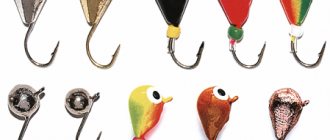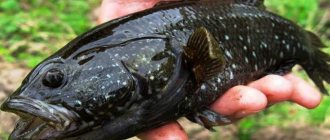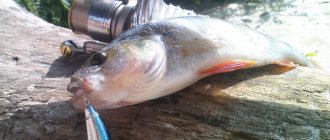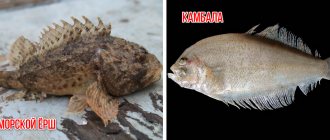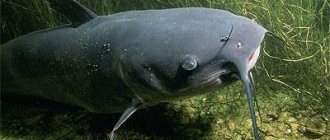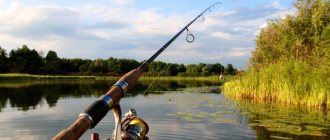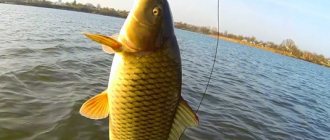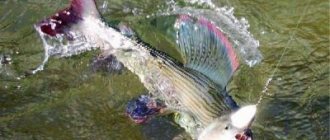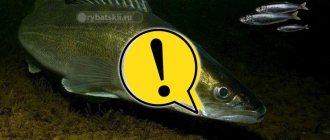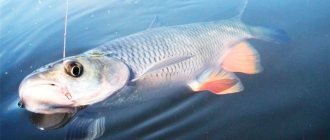| Class | Ray-finned fish |
| Squad | Salmonidae |
| Family | Salmonidae |
| Genus | Whitefish |
| View | Common whitefish |
| Security status | Some varieties are listed in the Red Book |
| The average size | 30 cm. |
| Lifespan | 8-12 years |
| What does it eat? | Plankton, worms, fry, insects, fish eggs |
| Optimal feeding time | Day |
| Enemies | Pike, Burbot, Perch, Ruff, seagulls, loons, ducks |
| What do they bite on? | Maggot, bloodworm, |
Description and photo of whitefish
There are many varieties of whitefish. Some of them are listed in the Red Book. Representatives of the genus can differ quite strongly from each other.
Certain individuals are so different from their counterparts that only an experienced fisherman can understand that it is whitefish. Even if a fisherman knows what the most common whitefish looks like, for example, the common whitefish, he may not recognize the caught muksun, which is from the same genus, as a member of the family.
Characteristic feature: lack of upper teeth.
The following subspecies are distinguished:
- bounty;
- European;
- Siberian;
- Chudsky;
- Volkhovsky;
- multistamen.
General signs:
- the scales are silvery, the body is elongated, the abdomen is light;
- lower mouth;
- fins of a dark shade;
- the adipose fin is small.
Characteristic feature: lack of upper teeth, expressive eyes.
Signs are sometimes subtle and vary in some individuals. The pronunciation of sik is incorrect. This is what the Siberian whitefish looks like: it is quite large, its body can reach 60 cm, and its weight is 2 kg.
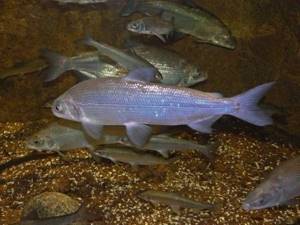
In one lake there may be fish that differ in external characteristics.
Individuals are distinguished:
- lake form;
- walk-through form;
- river type.
A trophy specimen can have different colors and sizes, and not every fisherman, having caught it, will be able to recognize the variety.
Representatives of salmon prefer water bodies with a high oxygen content. Some individuals stay closer to the surface of the water. Others sink to the bottom or swim into coastal waters.
On a new body of water, it is not always clear where the desired trophy is found and how to catch it, even if you are absolutely sure that it is possible to catch it in a given place. Whitefish is a cautious fish.
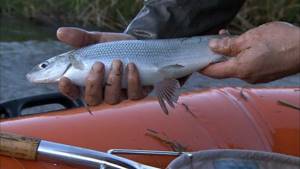
Large salmon, living in medium waters, weigh about 5 kg. These varieties include the pyzhyan, which can weigh 7 kg. In Siberia, where whitefish are found, a fisherman may be lucky enough to catch larger prey. It is not easy to catch such a trophy, and you will have to try hard to achieve it. The Siberian subspecies is a great success for the fisherman.
There are more than 50 varieties. Omul, vendace, peled are all varieties of whitefish. If you compare in the photo what the whitefish of the peled subspecies looks like and the pyzhyan variety, the differences will be visible to the naked eye.
Species of fish of the whitefish family
The whitefish family is widespread in water bodies of many continents, which are particularly clean. It includes relatively stable species with a limited range, and polymorphic specimens. That is why many intraspecific forms are formed, which will be discussed further.
Muksun
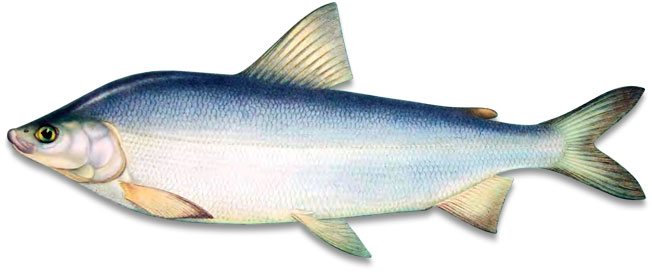
This is a freshwater fish with delicate pink flesh. It belongs to the semi-pass type. That is why migration is observed during the spawning process of the predator. You can find similar specimens in river reservoirs of Siberia. It is a permanent inhabitant of the desalinated waters of the Arctic Ocean.
Nelma

Nelma is a semi-anadromous and at the same time freshwater fish, which, like the previous species, prefers the waters of the Arctic Ocean. By going fishing in the mouths and deltas of large rivers in Siberia, you will have a chance to catch a predator.
Omul
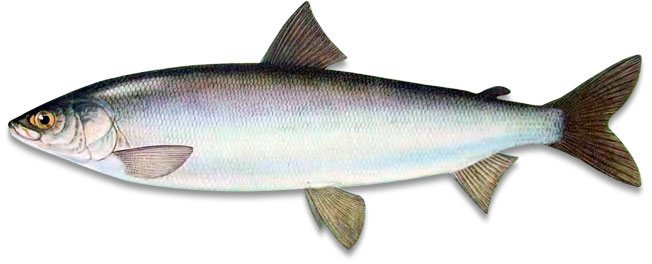
There are Baikal and Arctic omul. The first one prefers to live in bodies of water that originate from the Arctic Ocean. While the second specimen lives in Pechora, Yenisei, Lena, Kolyma, Indigirka and Khatanga.
Peled
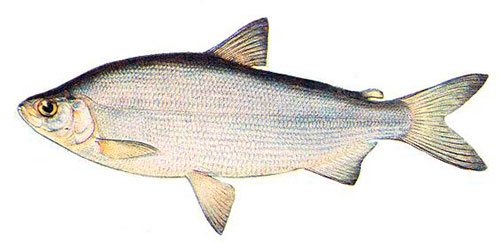
Peled, or as it is also called cheese, is a lake-river fish species, which is particularly valuable in terms of industrial fishing.
European fritillary
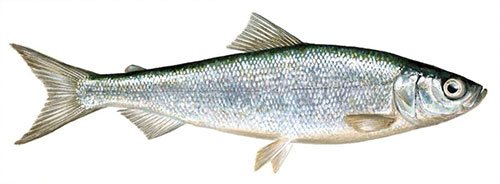
This is the smallest species of whitefish that prefers to inhabit the Baltic Sea basin.
Siberian grouse
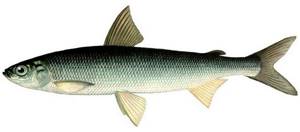
Siberian grouse or ripus or kilets is also a small fish that belongs to freshwater.
Passable whitefish
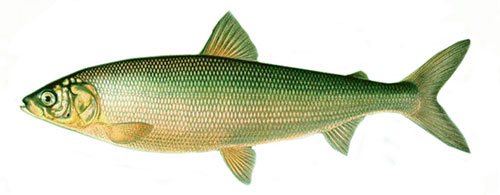
This is the most variable fish, capable of breaking up into a huge number of forms. They are similar to each other in the lower position of the mouth and head, which is larger than that of the broad whitefish, and has a less humpbacked snout.
Ussuri whitefish

This fish is also called Amur whitefish. She prefers the middle and lower reaches of the Amur, the Amur Estuary, the Strait of Tatar and the southern part of the Sea of Okhotsk.
Whitefish

This is a river fish whose habitat extends from the Yenisei to Chukotka, Alaska and the Atlantic coast of North America.
Tugun
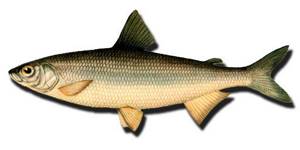
This type of fish is chosen endemic to Siberia, including rivers that flow into the Arctic Ocean.
Chir
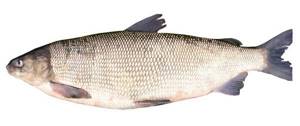
This is a small freshwater fish that mainly lives in the Arctic Circle.
Spawning
Representatives of salmon spawn in winter and autumn. This distinguishes it from known fish. Females do not cover all the eggs. During cold periods, it looks for warmer places. The eggs remain preserved until spring.
In spring and summer, the first fry emerge from it. You can find out what whitefish looks like as an adult from the Internet. The eggs are similar in appearance to trout eggs, but they are much smaller.
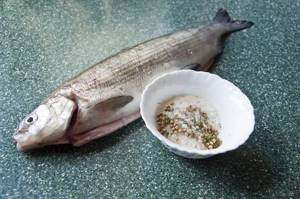
It actively bites in the spring and before the start of spawning. Hunting for it is truly an exciting activity.
Whitefish belongs to the salmon family
Whitefish is a very common predatory fish. The whitefish lives in Karelia, Western Siberia, and the Anadyr and Penzhina rivers.
The regions of Transbaikalia are home to a unique species of whitefish that spawns in the spring. There are more than 60 species of whitefish. The main differences between whitefish are based on the location of the mouth. Each species has its own size: large whitefish reach up to 10 kg. weight, and small individuals weigh only a few grams. The length is 70-80 cm. The body is covered with large scales.
- The sides are silvery, the back is dark. There are anadromous, river and lake forms of whitefish. Whitefish loves cold, clean water, abundant in oxygen. Whitefish fish begin to spawn at the age of 3 years. They go to spawn in late autumn, early winter. Eggs are laid in shallow places with pebble or sandy bottoms, both in rivers and lakes. Fertility is from 10 to 120 thousand eggs. The eggs develop until spring.
- Whitefish feed all year round. Their food is plankton and bottom organisms, so they are difficult to catch with fishermen’s baits. The best time to catch whitefish is when there is a shortage of natural food.
- They begin to feed on insects and are easily caught on insect-shaped baits. At the beginning of spring, after the ice melts, whitefish begin to eat. And they begin to feed on fry, smelt, and vendace.
- Whitefish is a fishery target.
Source: https://rybalka48.ru/ribi/sig.html
How, when and what to catch whitefish
Silverfish can be caught with a variety of gear:
- fly fishing;
- on a float rod;
- spinning tackle;
- for a winter fishing rod;
- path;
- jig tackle.
Lake whitefish are not like pike or perch. An imitation jig should be used as bait for such an individual. The hook used is three or four, according to Russian standards. In lakes, fish often gather in schools. It is better to start searching for them in shallow water.
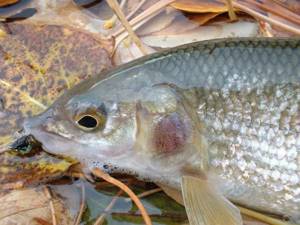
In rivers, large whitefish are caught using a medium fly. The fish attacks quickly, and you need to be able to hook it. You need to fight confidently, but carefully. Coregonus, as whitefish are called in Latin, when fished out, furiously try to return to their habitat and actively resist.
Fishing in winter and autumn
It is best to catch whitefish in the spring, although in winter it actively bites, mainly from the bottom. The line should be set a little thicker than when fishing for perch. A size from 0.2 mm is suitable. Spoons should be without threads in red and yellow shades, and have a narrow shape.
Ice fishing can continue from sunrise to sunset. When fishing with a jig, you can use bark beetle larvae. But there is no need to add additional bloodworms.
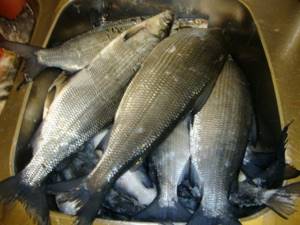
When fishing from ice with jig tackle, you need to try different baits. It may not be caught from the bottom. Sometimes fish attack at the bottom. The food-loving fish feed even in frosty conditions, and fishermen can reap a decent catch in winter. With the right bait, fishing is quite productive.
Whitefish is a schooling fish, so if a fisherman manages to stumble upon a family, he will not leave without a catch. Provided that the bait is selected correctly and the tackle is used.
When fishing, you should study places near ledges and rubble, turns and rifts. This makes hunting for whitefish different from fishing for other fish. The angler will have to try different gear and explore open water.

This “beast” is caught very well in the fall. During this period, the individuals have already gained weight and it is very pleasant to catch them. Worms, bloodworms, maggots, and fry are used as baits. The large specimen is cautious and will not simply allow itself to be caught. But fishing is also so bright and exciting.
Large whitefish are caught in the fairway, small fish - near the shore.
Coregonus prefer a depth of 4-6 meters.
Habitat and distribution
Whitefish lives both on the territory of the Russian Federation and beyond its borders. Places where it lives: the Urals, Lake Ladoga, Karelia, Baikal, reservoirs of the Murmansk region. There are few of these places in America: Canada and Alaska. It is also found on other continents.
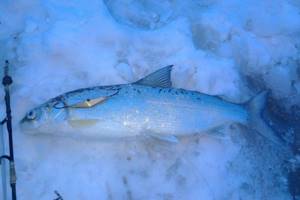
The Atlantic whitefish lives in Scotland. Rivers and lakes where whitefish are found are bodies of water with cool, oxygen-rich water. You can find out what American whitefish or the rare Baikal whitefish looks like on numerous forums and websites. Whitefish from Lake Baikal can reach a weight of up to 10 kg.
Distribution and habitats
The migratory whitefish has a circumpolar distribution. In Russia, it inhabits almost all water bodies of the Arctic Ocean basin, from the Barents and White Seas to Chukotka, it is found in the Penzhina and Anadyr rivers, but not in Amguem: it is also found in the Baltic Sea basin (Curonian and Finnish gulfs, reservoirs of Karelia). The Bauntovsky lakes (Transbaikalia) are home to a unique spring-spawning whitefish, which is classified as a special subspecies Coregonus lavaretus baunti. On the American continent, whitefish are recorded in the waters of Alaska and Canada; a closely related form, Coregonus clupeaformis (Mitchill, 1818), is found in many water bodies of North America.
Distribution and habitats of whitefish
Whitefish loves clear and oxygen-rich water. Stays in the water column. Depending on their size, whitefish lead a different lifestyle - smaller ones (weighing up to 500 g) stay close to the shore all year round, large whitefish (weighing from 1.5 to 6 kg) prefer to be in holes and under riffles next to fast streams . In the morning and evening, large whitefish come closer to the shore. Interestingly, the whitefish has a habit of surviving other fish from the hole it likes.
What does whitefish eat?
Whitefish eat both insects and fish eggs. He also eats minnows and bleak. It can attack prey either alone or in a flock.
When fishing in some waters, you must obtain a license. Certain subspecies of whitefish are listed in the Red Book. Catching them is strictly prohibited.
Important!
Often this salmon representative attacks its prey from a hiding place, which in most cases is a sand pit.
The desired trophy of any angler feeds all year round.
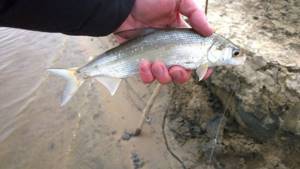
Large individuals lead a predatory lifestyle and feed on fry, small fish, and insects. It is remarkable what whitefish looks like during an attack. Coregonus are true predators. They attack prey from cover, sometimes in a whole flock.
A lot can be said about what whitefish looks like during hunting and fishing. But it’s better to see and feel it once.
Where does whitefish live?
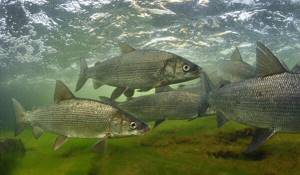
Photo: Whitefish in Russia
Its range includes almost all of Europe, including the European part of Russia. He also lives in northern Asia and North America.
In Europe, it is most common in the northern and central parts, including:
- Scandinavia;
- Great Britain;
- Germany;
- Switzerland;
- Baltics;
- Belarus.
In Russia, it inhabits the basins of most of the large rivers flowing into the seas of the Arctic Ocean, as well as many lakes: from the Volkhov River in the west and all the way to Chukotka itself. It is also found further south, but less frequently. For example, it lives in Baikal and other lakes of Transbaikalia. Although most of the whitefish's range in Asia is in Russia, these fish also live beyond its borders, for example, in the lakes of Armenia - for example, whitefish are fished in the largest of them, Sevan. In North America, the fish lives in the waters of Canada, Alaska, and the US states near the northern border. Previously, the Great Lakes, as well as the alpine lakes in Europe, were very populated by whitefish - but in both places, most of the previously inhabited species became extinct, others became very rare.
Whitefish live mainly in northern rivers and lakes because they combine all the qualities they prefer: the water in them is at the same time cool, clean and rich in oxygen. Whitefish are demanding of all of the above, and if the water becomes polluted, they quickly leave the reservoir or die out. This fish is fresh, but there are also species that spend part of their time in salt water, such as omul and Siberian vendace: they can rise to the mouths of rivers and spend time in bays, or even swim out to the open sea - but still must return to fresh water .
Young whitefish swim near the surface of the water and usually close to the shore, but adults tend to stay deeper, most often at a depth of 5-7 m, and sometimes they can even dive into holes on the river bottom and swim closer to the surface only to feed. They love to live near rifts with cool springs.
Now you know where whitefish are found. Let's take a look at what fish eat.
How does whitefish reproduce?
Male whitefish reach sexual maturity at 3 years of age. Females mature later. They often become sexually mature at 6 years of age. The place where whitefish lay their eggs is the river fairway.
Interesting!
Whitefish of different species interbreed with each other when they find themselves in unfamiliar habitats. Whitefish spawn in sand and pebbles. Prefers to choose pits for these purposes.
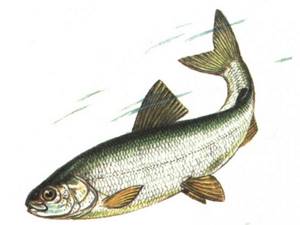
If you have wondered what a whitefish looks like when it is growing up, then the answer to this question is simple. Adult whitefish, like well-known and common fish, grow from fry.
The female leaves more than 25,000 eggs. Coregonus eggs are spawned at water temperatures of +2…+5C.
The incubation period is quite long. It lasts up to 200 days.
This beautiful and neat fish has enough enemies. The most basic of them are helminths, to put it simply, worms. They can penetrate both the gills and the intestines of the whitefish. That is why fish of this species must be very carefully processed before consumption. If you brine whitefish, do it for a long time.
Bugs and beetles are dangerous for fry.
Whitefish spawning
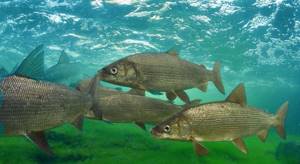
Since the life expectancy of whitefish is quite long, they reach sexual maturity quite late. Males become sexually mature after 4 years, and females closer to 6 years. Fish usually spawn in the fall. Whitefish spawning begins in mid-September and can last until December. Before they begin to spawn, the fish form numerous schools. Whitefish are divided into three species, depending on their spawning location. River whitefish spawn within the river in which they live, with the only difference being that they can travel up the river. Lake whitefish spawn within the lake. Lake-river whitefish live in the lake, but go to the river to spawn. The optimal water temperature for throwing game is up to 5 degrees above zero. Females lay about 30 thousand larvae. For spawning, the female chooses a backwater with rich vegetation. Whitefish spawn annually. After spawning, the fish swims away, and the eggs wait to hatch. After emerging from the egg, the larva is very small. Its size barely reaches a centimeter. The future fish spends about 40 days in the larval stage. All this time the larva does not leave the place of its appearance. It grows and feeds on plankton. The larva becomes a fry when its length reaches 4 centimeters. At this time, the small predator actively feeds on crustaceans and insect larvae. Gradually, the fish begin to move along the river and actively hunt for small fish. By the age of one year, the fry become juveniles.
Population and species status
Many whitefish species are divided into subspecies based on their habitat. The lacustrine whitefish lives and breeds within its native body of water. The river form also gravitates towards its native places, but during the spawning period, individuals can swim to the upper reaches of the river.

The migratory whitefish is significantly different from its counterparts. It is more elongated in shape and its color is darker. There is a clearly visible hump on the back. What a whitefish looks like living in the same body of water depends on various factors. Individuals from the same lake often differ both in appearance and in their taste preferences.
Just 18 years ago, only two species were included in the Red Book. Today there are many more of them. The number of whitefish, unfortunately, has decreased greatly. This especially affected Lake Peipsi. Bauntovsky, Volkhovsky, Chudsky and even common whitefish - all these species are on the verge of extinction and are listed in the Red Book, because their population is rapidly declining.
You can now only find out what rare whitefish looks like from the Internet. On the same Lake Peipus, its catching is completely prohibited.
Spawning and feeding of fish
A sexually mature individual is considered at the age of three years . Whitefish spawn in fresh water bodies, on shallows with a sandy bottom and dense vegetation. Spawning occurs in the fall and can continue until the end of winter. In this case, the temperature should not exceed five degrees Celsius. The female is capable of producing up to 45 thousand eggs. The warmer the water, the faster the fry appear.
The fry feed on plankton, and large fish eat the fry themselves, mollusks, crustaceans and small fish. The whitefish waits for the victim while being in the hole. It will not disdain its brothers, especially if they are smaller in size. Predators find food everywhere without difficulty. The fate of the caviar is of little concern to them. Females, leaving the spawning site, do not cover the nest. The hatched fry stay in large flocks for about 2 months, without leaving the shores. As they grow up, the flock disintegrates, since adult individuals prefer to live and hunt alone, gathering during the spawning period.
The weight of a one-year-old individual reaches 100 g, and the body length is up to 30 cm.
Taste qualities of whitefish
Whitefish is quite tasty. It is low in bone and low in calories. The handsome guy has fatty white meat, which contains a lot of different beneficial microelements, vitamins and minerals. Such food is useful for anemia and some chronic diseases. The composition includes Omega 3, a very important and extremely useful substance.
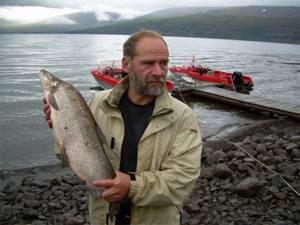
The caviar of this representative of salmon is equated to salmon, it is so tasty and healthy.
Popular recipes
One of the positive qualities of commercial fish is that it can be prepared in a variety of ways. Whitefish are fried and boiled, smoked and pickled, stewed and stuffed. A huge number of different dishes are prepared from it.
Fried whitefish is a very tasty dish that will be a wonderful decoration for the holiday table. The recipe is quite simple.
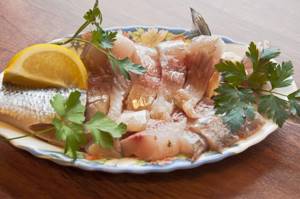
Ingredients:
- fish carcass;
- egg;
- butter and sunflower;
- turmeric;
- salt and pepper;
- wheat flour.
1 kg. enough whitefish to prepare 4 servings. If you want to know what fried whitefish looks like, just go to any culinary site. This fish is delicious and, with due diligence, it produces amazing dishes.
Whitefish is a commercial fish that is now on the verge of extinction. They are trying to preserve the population by allowing its fishing only in certain reservoirs and introducing a fishing license
In the Urals and Yakutia, these salmon are mainly caught by professional fishermen.
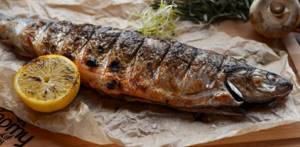
Photos and descriptions of whitefish of different species can vary greatly.
He has quite a lot of enemies, from helminths to ducks.
Catching a trophy specimen is entertaining. You can catch it with a float rod, a baitcaster, or a spinning rod. The beauty of whitefish is that landing large specimens is truly an interesting experience. The large Siberian whitefish is very careful and will not easily be given to the fisherman.
The fisherman will have to try hard to find its habitat. It is not easy to catch such prey. But the reward will be a very tasty trophy, which can be salted, smoked, and fried.
Not every fisherman can boast that he has caught a whitefish. This is especially true for the species of pyzhyan and muksun.
Whitefish fishing
Whitefish fishing Commercial fishing of whitefish is carried out mainly with nets and in reservoirs specially designated for its breeding.
A license is required for recreational and sport fishing of whitefish; in addition, a limit is set for the catch of whitefish of any type. Whitefish is an interesting object of sport fishing. The main reason for this is that whitefish meat is very tasty and tender. In addition, it is extremely useful: it contains fats, proteins, substances such as molybdenum, chlorine, nickel, fluorine, zinc, chromium, and vitamins. Whitefish meat is white, despite the fact that it is a salmon (red fish). As you know, any fish that lives in cold northern waters has a high fat content. Sig was no exception. Its fat contains a high concentration of vitamin A (good vision), vitamin D (strong bones).
They fish for whitefish in the summer, when the fish “walks” along the river in search of food. You need to look for it in holes with reverse currents, on rifts in sunny weather. Whitefish fry are found on high banks, where they flock together in schools and stand under the shore. Larger individuals prefer deeper places.
In a pond, whitefish are quite aggressive and often displace any other fish from their habitat. This property can also be used for fishing. Thus, in the spring, whitefish are often found in places where fry and any small schooling fish gather.
In winter, whitefish stand in pits and winter fishing for whitefish comes down to searching for such pits. The most catchy period of winter whitefish fishing is considered to be the period of last ice, i.e. in the spring. In this respect, whitefish is very similar to its brother, grayling. With the onset of spring warming, when the water begins to be enriched with oxygen, whitefish begin to feed very actively, fattening up the fat lost over the winter.
They catch whitefish using any tackle: from a float rod to a fly rod. Whitefish are not cautious fish, so no special precautions are required when fishing.
Whitefish, due to its fat content, is a perishable fish (again, like grayling), so immediately after catching it must either be eaten or salted (smoked).
